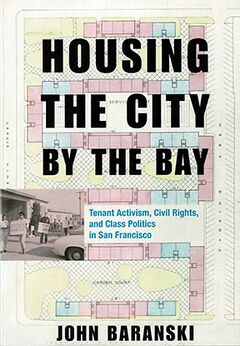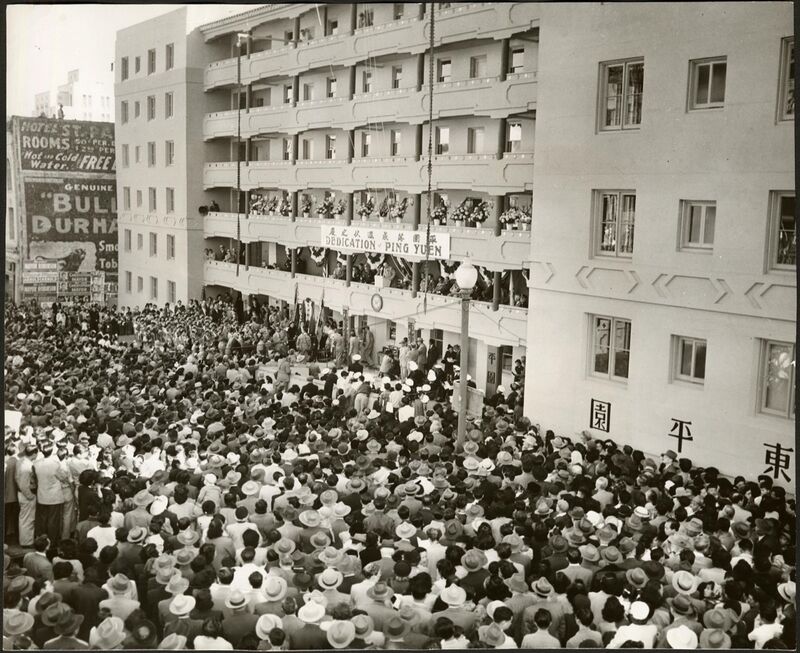Chinatown Tenants Win Public Housing Rent Strike
Historical Essay
by John Baranski
This excerpt originally appeared in "All Housing is Public," Chapter Seven of Housing the City by the Bay: Tenant Activism, Civil Rights, and Class Politics in San Francisco (see below for copyright and book information)
Dedication of the Ping Yuen East Housing Project, October 22, 1951.
Photo: San Francisco History Center, SF Public Library
In August 1978, a man sexually assaulted and murdered Julia Wong, an 18-year-old tenant of Ping Yuen, as she walked up the stairs to her apartment. The media turned the case into a sensational story that reinforced popular stereotypes of public housing: dangerous and crime-ridden. Less noted in the media was how tenants responded. Public housing tenants blamed insufficient lighting, a broken elevator, and security at the building as underlying causes—all problems that their tenant association had urged the San Francisco Housing Authority (SFHA) to address. They also blamed the San Francisco Police Department for not protecting and serving their neighborhood.(2)
The authority’s failure to act before and after the tragedy mobilized the tenants and community behind a rent strike. Tenants met regularly, put their rents in escrow, and stayed unified. The SFHA eventually responded with security guards, more bilingual staff, and additional lighting. The strike had succeeded. On February 26, 1979, Ping Yuen tenants threw a Unity Party, inviting tenants from other SFHA projects to celebrate their gains and plan for the future.(3)
Their success, and the follow-up celebration, encouraged tenants from neighboring North Beach Place to take similar actions. Asian, white, African American, Native American, and Latina/o tenants there pressured SFHA Director Carl Williams to install more lights and add more security at their project. They used the same law- yer who had represented the Ping Yuen tenants and threatened a rent strike if their demands were not met. Tenants at other SFHA projects framed similar demands with the threat of a strike. Williams agreed to new lighting but insisted the authority could not continue responding to every tenant threat and action. Williams and the commissioners worried about the rent strike “syndrome” sweeping the public housing community and the lack of resources to meet tenant demands.(4)
Williams was right to worry about the lack of SFHA resources. His under-funded agency already did not have enough money to meet its daily expenses, which increasingly included new services and, as noted above, public safety measures. But two developments made the SFHA’s financial situation even more precarious. First, the SFHA did not have the reserves or a realistic chance of winning federal grants to pay for a long list of major repairs at the apartment and project level. The physical decline of some SFHA properties led to uninhabitable units and even entire projects, and these vacancies reduced rental income and SFHA’s capacity to house the city’s tenants. The second development was the federal government’s continued preferences to fund alternatives to public housing, a trend that continued with the Carter administration and then accelerated under the Reagan administration. HUD programs, in short, funneled more federal housing dollars to private landlords and investors while doing less to assist the nation’s public housing program. The shift in federal housing policy was in line with the broader intellectual and political attack on the welfare state, government regulations, taxes, and the poor. This neoliberal philosophy of government produced new legislation and priorities that significantly undermined New Deal and Great Society programs as well as labor and tenant unions.
Within this national political context, San Francisco’s tenants remained politically active, though on a smaller scale compared to the previous decade. Public and private housing tenants alike continued to look to the SFHA for help in securing housing and economic and civil rights. In these struggles, tenants continued to support a role of government that was out of step with political and economic elites. SFHA tenants in particular reinforced their identity as tenants and built a strong sense of community through the SFHA program. But in San Francisco, the tenant movement had trouble sustaining its vitality and energy. Federal neoliberal policies drove much of this decline, but so did the increasingly difficult political and economic world of tenants. In some ways, the decline in tenant power matched the decline in the federal commitment to public housing. The image of public housing in and out of the city became more negative, and this, too, damaged political support for the program, contributing to the neoliberal war on the poor that made possible the deep cuts to the welfare state during the Reagan–Bush administrations.(5)
On February 1, 1977, leaders of the National Tenants Organization (NTO) met with Patricia Harris, the new, Carter-appointed HUD secretary, to discuss the future of HUD policies. As with many housing professionals and public housing tenants, the NTO leadership was hopeful that, after years of Republican administrations, HUD might better respond to the needs of tenants who struggled in the declining economy. NTO Chairman Jesse Gray spelled out his organization’s priorities for HUD. At the top of the list, the NTO wanted “to see the government get back into the business of building houses” and reverse the trend of subsidizing private property owners. The NTO called “for a mass rehabilitation fund to preserve inner city housing,” “the provision of sufficient operating subsidies to bring public housing up to decent and livable standards,” and “an increase in public housing utility allowances” for tenants suffering from inflation. The NTO also wanted utility subsidies for all renters, who suffered from “astronomical utility bills.” It asked HUD to create “a national tenants leadership training program” and to provide seats for tenants on the HUD policy board to improve communication between HUD staff and tenants. Also, the NTO requested a plan to develop a “national tenants minimum bill of rights” that included protections for tenant activists and tenant preferences for HUD-funded jobs.(6) These proposals were intended to add housing and jobs and expand the political and economic rights of not only the 4 million tenants in the 1 million units of public housing managed by 2,600 local authorities, but of millions of tenants in the private sector as well.(7)
Along with proposals for more tenant resources and rights across the nation, the NTO also wanted to make HUD policymaking more responsive to tenants and more egalitarian. In the past, tenant groups met with HUD, but in informal and nonstructured ways. At the 1977 meeting, NTO representatives urged Harris to give tenants “a say equal to that of housing authority officials, bankers, real estate officials, builders and landlords.” To bring this about, Gray proposed “a HUD policy board of tenants to work with the Department in policy development” and HUD assistance to cover the travel costs of tenants who came to Washington for this work.(8)
The NTO formulated these demands after two decades of tenant organizing for economic, civil, and political rights. The NTO demands also reflected the decline in the standard of living in many households. HUD responded with a national tenant task force and committees and conferences for women, disabled, and senior tenants. Yet the agency’s priorities remained focused more on redevelopment and private housing than on public housing. HUD left unchanged the operating formula for local public housing authorities, which limited the funding for services to the increasingly diverse tenant populations and repairing aging buildings and infrastructure, some of which dated to the 1940s. As of 1978, the SFHA program, for example, had $45 million worth of deferred work to do on its buildings.(9)
HUD also ramped up its Section 8 program. Created in 1974, the Section 8 program provided housing authorities with rental vouchers that paid 75 percent of HUD’s Fair Market Rent calculation for units in newly constructed and rehabilitated housing or in existing housing. Section 8 household recipients paid 25 percent (later 30 percent) of their adjusted family income to the landlord. The program rewarded landlords with market rate rents and became Congress’s preferred choice for low-income housing assistance, while taking funding away from local housing authorities.(10)
Notes
2. “A Celebration by Project’s Tenants,” San Francisco Chronicle (February 22, 1979); Neighborhood Improvement Update, 1, 8 (January 1979), Folder “Chinatown Neighborhood Improvement Resource Center,” Box 1, MS 1647 SPUR, CHS.
3. Ibid.
4. North Beach household demographics broke down in the following way: ninety-five Asian, fifty-four white, forty-seven African American, one Native American, four Latinas/os, and nine other. “Fed-Up Tenants Fight City Hall,” San Francisco Chronicle (February 26, 1979). Amy Lynne Howard, More Than Shelter: Activism and Community in San Francisco Public Housing (Minneapolis: University of Minnesota Press, 2014).
5. Herbert J. Gans, The War Against the Poor: The Underclass and Antipoverty Policy (New York: Basic Books, 1995).
6. Jesse Gray to Patricia Harris, letter (February 2, 1977), Folder “Rel 8 Suggestions and Views from the Public,” Box 38 1977, Subject Correspondence, 1966–78, RG 207, NARA/CP. On the initial “guarded optimism” among housing professionals and tenants, see SFHA commissioner reports from the National Housing Conference and NAHRO’s conferences in SFHA, Minutes (March 10, 1977). R. Allen Hays, The Federal Government and Urban Housing (New York: SUNY Press, 2012); Roger Biles, The Fate of Cities: Urban America and the Federal Government, 1945–2000 (Lawrence: University Press of Kansas, 2011).
7. Patricia Harris to Director of OMB Bert Lance, letter (August 9, 1977), Folder “PRO
8. Low Rent Public Housing, Jan.–May,” Box 35 1977, Subject Correspondence, 1966–78, RG 207, NARA/CP.
8. Gray to Harris (February 2, 1977).
9. Harris to Lance (August 9, 1977). On national priorities, see Hays, The Federal Government and Urban Housing; Chester Hartman, City for Sale: The Transformation of San Francisco (Berkeley: University of California Press, 2002); SFHA, Minutes (February 23 and March 9, 1978).
10. Other HUD programs included tax credits for low-income housing investors and subsidies for privately built and owned (for profit and nonprofit) housing. These programs also drained money from the public housing program. For Section 8, see Hays, The Federal Government; Alex F. Schwartz, Housing Policy in the United States (New York: Routledge, 2014).

Excerpted from Housing the City by the Bay: Tenant Activism, Civil Rights, and Class Politics in San Francisco by John Baranski, published by Stanford University Press. Used by permission. © Copyright 2019 by John Baranski. All rights reserved.

